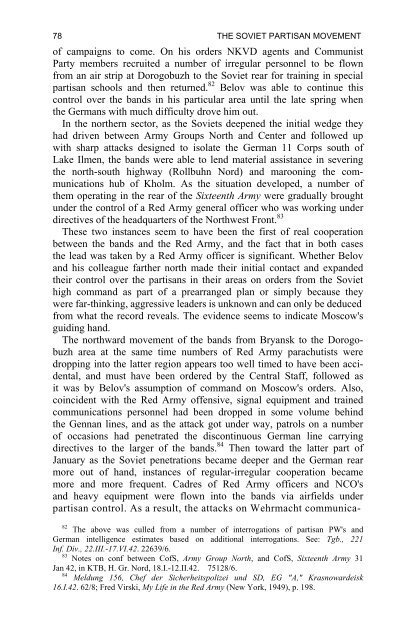the soviet partisan movement 1941-1944 by edgar m. howell
the soviet partisan movement 1941-1944 by edgar m. howell
the soviet partisan movement 1941-1944 by edgar m. howell
Create successful ePaper yourself
Turn your PDF publications into a flip-book with our unique Google optimized e-Paper software.
78 THE SOVIET PARTISAN MOVEMENT<br />
of campaigns to come. On his orders NKVD agents and Communist<br />
Party members recruited a number of irregular personnel to be flown<br />
from an air strip at Dorogobuzh to <strong>the</strong> Soviet rear for training in special<br />
<strong>partisan</strong> schools and <strong>the</strong>n returned. 82 Belov was able to continue this<br />
control over <strong>the</strong> bands in his particular area until <strong>the</strong> late spring when<br />
<strong>the</strong> Germans with much difficulty drove him out.<br />
In <strong>the</strong> nor<strong>the</strong>rn sector, as <strong>the</strong> Soviets deepened <strong>the</strong> initial wedge <strong>the</strong>y<br />
had driven between Army Groups North and Center and followed up<br />
with sharp attacks designed to isolate <strong>the</strong> German 11 Corps south of<br />
Lake Ilmen, <strong>the</strong> bands were able to lend material assistance in severing<br />
<strong>the</strong> north-south highway (Rollbuhn Nord) and marooning <strong>the</strong> communications<br />
hub of Kholm. As <strong>the</strong> situation developed, a number of<br />
<strong>the</strong>m operating in <strong>the</strong> rear of <strong>the</strong> Sixteenth Army were gradually brought<br />
under <strong>the</strong> control of a Red Army general officer who was working under<br />
directives of <strong>the</strong> headquarters of <strong>the</strong> Northwest Front. 83<br />
These two instances seem to have been <strong>the</strong> first of real cooperation<br />
between <strong>the</strong> bands and <strong>the</strong> Red Army, and <strong>the</strong> fact that in both cases<br />
<strong>the</strong> lead was taken <strong>by</strong> a Red Army officer is significant. Whe<strong>the</strong>r Belov<br />
and his colleague far<strong>the</strong>r north made <strong>the</strong>ir initial contact and expanded<br />
<strong>the</strong>ir control over <strong>the</strong> <strong>partisan</strong>s in <strong>the</strong>ir areas on orders from <strong>the</strong> Soviet<br />
high command as part of a prearranged plan or simply because <strong>the</strong>y<br />
were far-thinking, aggressive leaders is unknown and can only be deduced<br />
from what <strong>the</strong> record reveals. The evidence seems to indicate Moscow's<br />
guiding hand.<br />
The northward <strong>movement</strong> of <strong>the</strong> bands from Bryansk to <strong>the</strong> Dorogobuzh<br />
area at <strong>the</strong> same time numbers of Red Army parachutists were<br />
dropping into <strong>the</strong> latter region appears too well timed to have been accidental,<br />
and must have been ordered <strong>by</strong> <strong>the</strong> Central Staff, followed as<br />
it was <strong>by</strong> Belov's assumption of command on Moscow's orders. Also,<br />
coincident with <strong>the</strong> Red Army offensive, signal equipment and trained<br />
communications personnel had been dropped in some volume behind<br />
<strong>the</strong> Gennan lines, and as <strong>the</strong> attack got under way, patrols on a number<br />
of occasions had penetrated <strong>the</strong> discontinuous German line carrying<br />
directives to <strong>the</strong> larger of <strong>the</strong> bands. 84 Then toward <strong>the</strong> latter part of<br />
January as <strong>the</strong> Soviet penetrations became deeper and <strong>the</strong> German rear<br />
more out of hand, instances of regular-irregular cooperation became<br />
more and more frequent. Cadres of Red Army officers and NCO's<br />
and heavy equipment were flown into <strong>the</strong> bands via airfields under<br />
<strong>partisan</strong> control. As a result, <strong>the</strong> attacks on Wehrmacht communica-<br />
82<br />
The above was culled from a number of interrogations of <strong>partisan</strong> PW's and<br />
German intelligence estimates based on additional interrogations. See: Tgb., 221<br />
Inf. Div., 22.III.-17.VI.42. 22639/6.<br />
83 Notes on conf between CofS, Army Group North, and CofS, Sixteenth Army 31<br />
Jan 42, in KTB, H. Gr. Nord, 18.I.-12.II.42. 75128/6.<br />
84<br />
Meldung 156, Chef der Sicherheitspolizei und SD, EG "A," Krasnowardeisk<br />
16.I.42. 62/8; Fred Virski, My Life in <strong>the</strong> Red Army (New York, 1949), p. 198.
















